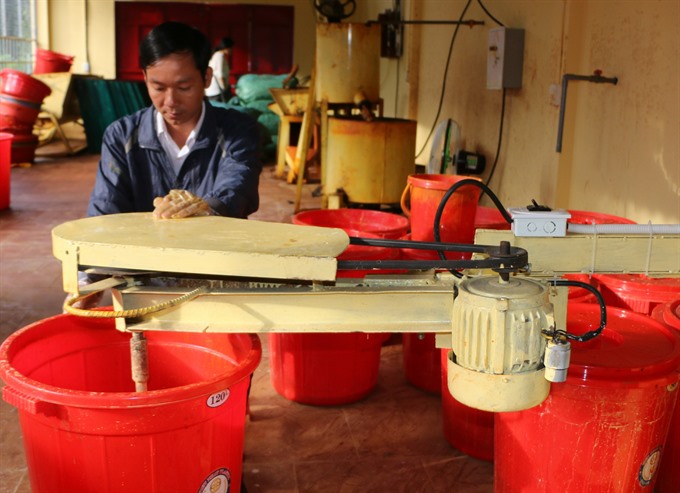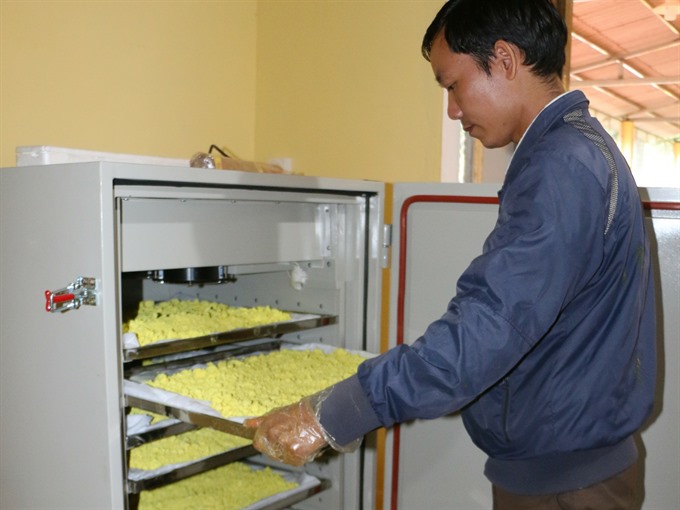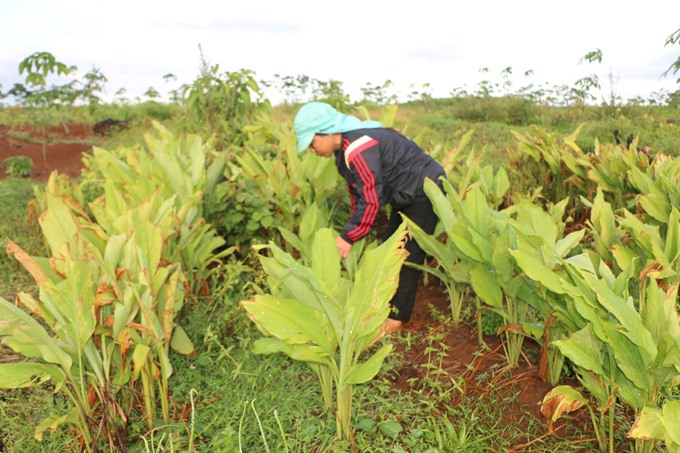 Society
Society

The turmeric growing area of Gio An Commune in the central province of Quảng Trị is a vast area with lush green plants and rich red-brown soil.
 |
| Turmeric manufacturer in Gio An commune of the central province of Quảng Trị operates a centrifugal machine to process the plant. — VNS Photo Đoàn Tùng |
Bảo Hoa
The turmeric growing area of Gio An Commune in the central province of Quảng Trị is a vast area with lush green plants and rich red-brown soil.
Located in the commune’s An Hướng Village, the approximately 100ha area is in fact a rubber plantation that has been leased to local residents to grow short-day plants - those requiring long hours of darkness - while waiting for the rubber trees they planted to grow.
Yams, cassavas, peppers and a variety of short-day plants have been cultivated here. Turmeric, a plant used as a dye and spice, is among the most profitable that have helped improve the income of local households.
Farmer Lê Thị Thanh Nhàn, 51, has some 2ha of land. She started growing turmeric at the beginning of last year, and by January this year she was able to harvest an average of 100 tonnes of fresh turmeric. Selling them at VNĐ1 million (US$44) per tonne, Nhàn earned VNĐ100 million ($44,000) for a year’s work.
“If I wait until the turmeric season has passed and no one else is selling it, I can sell it at one and a half times the price,” she said. “But as an annual plant, turmeric is at its best quality when harvested one year after the seeds are cultivated.”
Easier than rubber
The best time to grow turmeric is between March and April, Nhàn said. It is easily planted, does not require great care, and sprouts after some three months if the weather is favourable, she added.
“It can grow in any type of weather and does not require regular watering. Only natural rains and occasional grass removals are enough,” Nhàn said. “Growing turmeric is definitely less laborious than growing rubber, which required us getting up at 1-2am to tap rubber latex.”
Apart from selling fresh turmeric, Gio An residents also produce and sell turmeric powder. Farmer Lâm Thị Hoa, a skilled turmeric powder processor in the commune, said it takes 10kg of fresh turmeric to produce one kilogram of turmeric powder.
At a price of VNĐ450-500,000 ($20-22) per kilogram of powder, selling turmeric powder is more profitable than selling the fresh plant, she said.
Producing turmeric powder requires a lot of work, according to Hoa. Fresh turmeric has to be washed and peeled carefully after being harvested, then put in a crusher, then in a centrifugal machine to squeeze water out.
A manual sedimentation technique will then be used to separate oil from the turmeric residue, which will result in original turmeric starch. This wet starch will then be dried with infrared lamps and ultraviolet ray to kill viruses and bacteria, then dried again with specialised dryers.
The drying process finishes ends when the moisture content of the starch reaches 1-2 per cent. The powder is then either packaged or vacuum packed, depending on customers’ preferences.
“This meticulous drying process will reduce the strong turmeric smell that might be unpleasant to some people. The smell will still linger on the powder, but very lightly,” Hoa said.
The residents’ effort to grow turmeric has been supported by local authorities. Lê Phước Hiếu, vice chairman of the Gio An People’s Committee, said that turmeric had been prioritised as the commune’s new direction for economic development.
“Some 200 households were growing the plant in a total of some 65ha of land in 2016, and we are planning to increase it to 95ha by the end of this year,” he said. “Last year the farmers earned an average of VNĐ9-12 billion ($396,000-528,000) from selling fresh turmeric and turmeric powder, 60 per cent of which is profit,” Hiếu added.
“Planning short-day plants, especially turmeric, has helped reduce the commune’s poverty rate to below 5 per cent in recent years,” he said.
Since the majority of turmeric growers process fresh turmeric manually by themselves, the authorities have encouraged five households to join in establishing a 150sq.m manufacturing unit with professional plant processing equipment, according to Hiếu.
“We are trying to have a stable amount of output and developing a brand for local agricultural producing and processing, specialising in not only turmeric but also pepper, cassava and other short-day plants,” he said.
“It is hard to persuade all farmers to join in at this stage because it costs money to get the necessary certificates and verification, but this is something we have to do if we want our products to go far and reach big cities,” he said. — VNS
 |
| Turmeric manufacturer in the central province of Quảng Trị pulls out a tray of turmeric powder from a specialised dryer. — VNS Photo Đoàn Tùng |
 |
| Farmer Lê Thị Thanh Nhàn in the central Quảng Trị Province’s Gio An Commune pulls out weeds around her turmeric plants. — VNS Photo Đoàn Tùng |